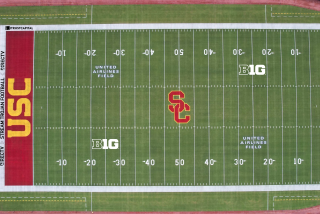Big West Wants a Big League Share of Sports Marketing Pie
- Share via
Its member schools account for more than 200,000 students and a million living alumni, but the Big West athletic conference has traditionally been stuck in the shadow of the powerful Pacific 10, home to USC and UCLA.
Now the Big West wants a bigger share of the collegiate sports revenue pie. The little-known NCAA athletic conference has hired a big-name sports marketing guru to promote its image among potential corporate sponsors.
Collegiate athletics is a hot property, particularly among marketers targeting media-savvy consumers between the ages of 18 and 24. CBS Sports raised the stakes in 1999 by signing a long-term, $6-billion NCAA broadcast package that gives the network access to the popular “March Madness” basketball tournament and other sports programming.
The point men in the Big West’s effort are sports marketing consultant Leigh Steinberg of Newport Beach--a consultant on the “Jerry Maguire” movie, starring Tom Cruise--and Jonathan Atha, a former USC athletic department executive.
The conference’s first marketing step is the Big West basketball tournament, which tipped off Wednesday night with first-round women’s games at the Anaheim Convention Center.
Steinberg, who represents such high-profile athletes as Drew Bledsoe, Kerry Collins and Troy Aikman, acknowledges that the Big West must polish its image as the conference undertakes the years-long process of marketing its brand of collegiate athletics.
“There has been confusion out there about what the Big West represents,” Steinberg said. “But going forward, there’s a real sense of who the Big West is and what it represents.”
The Big West’s challenge “comes down to brand management,” said Rick Burton, director of the James H. Warsaw Sports Marketing Center at the University of Oregon. “If USC or UCLA is Coke, then what’s the Big West? Is it Dr Pepper or is it Albertsons’ generic brand?”
The Big West caused some of its own identity problems. Over the years, the conference has embraced such institutions as Arkansas State, Northern Illinois and Southwestern Louisiana. It pitched itself as a basketball-oriented conference, then tried to reshape its image as a football conference.
Now the 32-year-old conference seems ready to live within the geographical confines of its name. Next year, the conference will take on a decidedly California tilt when UC Riverside and Cal State Northridge join Big West member schools UC Irvine, UC Santa Barbara, Cal State Long Beach, University of the Pacific, Cal Poly San Luis Obispo, Cal State Fullerton, Utah State and Idaho.
Although universities generally sign their own sponsorship deals, conferences generate added revenue that is split among members. The marketing alliances run the gamut from automobile companies and grocery stores to fast-food chains and financial institutions.
But sports marketers say the Big West has not leveraged its considerable demographic base. The conference’s major source of revenue has been a $100,000 annual payment from the Convention and Visitors Bureau in Reno.
In contrast, the Atlantic 10 conference generates nearly $1 million from a basketball tournament and associated corporate sponsorships. Money earned by the nonprofit conferences is returned to member schools to help subsidize athletic programs.
Corporate sponsors receive on-air advertising rights, signage at the venues and game tickets that can be used to reward important clients. Conferences also make coaches available for “meet and greet” functions and provide corporate hospitality sites at games.
Conferences also can give marketing partners an on-campus connection to free-spending students--an important marketing outlet for companies pitching everything from candy bars and soda pop to compact discs and clothing.
Steinberg’s arrival coincides with a natural break in the action for the Irvine-based Big West.
An ESPN television contract dating back to the early 1990s, when basketball coach Jerry Tarkanian’s University of Nevada at Las Vegas Runnin’ Rebels were an NCAA basketball powerhouse, expires this year. The basketball tournament is moving to Anaheim from distant Reno.
The league also confused fans as such schools as Cal State Los Angeles, Fresno State, UNLV and San Diego State came and went.
Although some institutions continue to play football, the league has dropped that expensive sport. The conference also severed a connection to the postseason Humanitarian Bowl game played in Boise, Idaho, and is shifting the spotlight to men’s and women’s basketball and such sports as baseball, softball, volleyball, soccer and swimming.
The Big West now says its ranks have finally stabilized.
“We went through a period of time when we couldn’t change the stationery fast enough,” said Cal State Long Beach President Robert C. Maxson, who serves as conference president. “This is my 17th year in the Big West, and I’ve never felt better about how it is positioned. It’s right where we want to be.”
Maxson, who was president of UNLV during Tarkanian’s coaching reign, has witnessed the potential and problems that on-the-court success generates. He was at UNLV in the early 1990s when the NCAA put the school on probation and Tarkanian subsequently resigned.
“I love the visibility of sports and the huge window it gives us to the public,” Maxson said. “I also like what it does for my campus. But sports are not an end in and of themselves. . . . They are a way to complete the college experience.”
During what Steinberg describes as a “years-long process,” the conference hopes to use the tournament in Anaheim to build the foundation for its sports marketing programs. The last time the tournament was held in California was in 1993.
The Big West is betting that it can bolster its bottom line by increasing ticket sales in crowded Southern California and, eventually, crafting a stronger TV deal.
Some sports marketers say the conference, which is improving its overall quality of play, will continue to be an attractive candidate for Fox’s regional programming.
Basketball tournaments are an integral part of the sports-marketing machine. With the exception of the Pac-10, every Division I conference has one. (The Pac-10 will fall into line after the 2001-02 season.)
“The tournament is your major event for the conference,” said John Kasser, vice president of Pac-10 Properties, a joint marketing venture of the conference and Fox Sports Net, which televises Pac-10 games. “And when you have a tournament, you have a major asset that can be used to create value for your corporate sponsors.”
Marketers agree that smaller conferences can attract corporate sponsorships.
“You adopt a pricing strategy that kind of undercuts what the big guys--the UCLAs--can’t afford,” the University of Oregon’s Burton said. “Leigh Steinberg is a brilliant guy, so he has plans on how to attack.”
What kind of sponsorships do athletic conferences seek? The Metro Atlantic Athletic Conference counts EA Sports as its official licensed video games supplier, HSBC as its official bank, Clairol as the preferred hygiene and beauty product supplier and Jostens as its awards supplier.
Smaller conferences must know their limitations.
“My direct competition is the Big East, and I’ve probably lost a million dollars in potential business to them,” said Jeff Long, corporate sponsorship director for the Atlantic 10. “But what I have to offer is a quality program with great reach at an affordable price.”
Success on the athletic fields can drive corporate revenue, but it also can polish an academic institution’s image.
When Cal State Long Beach’s Maxson recruits high school students who are at the top of their academic classes, he includes a tour of the Pyramid, the athletic center where the 49ers’ championship banners are unfurled.
“These kids are academic superstars, but they’re all mindful of sports,” Maxson said. “They want a school that has a complete package.”
(BEGIN TEXT OF INFOBOX / INFOGRAPHIC)
Money for College
The value of collegiate athletics skyrocketed in November 1999 when the NCAA signed a long-term broadcast agreement with CBS Sports for television, radio and Internet broadcast rights.
*
Estimated payments by CBS Sports to NCAA, in millions
2012-2013: $764 million
Source: NCAA
More to Read
Go beyond the scoreboard
Get the latest on L.A.'s teams in the daily Sports Report newsletter.
You may occasionally receive promotional content from the Los Angeles Times.










